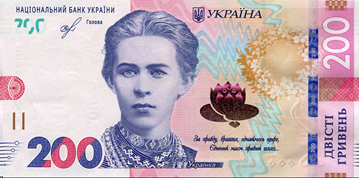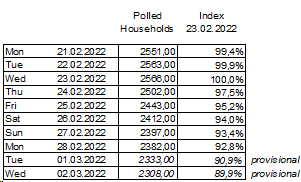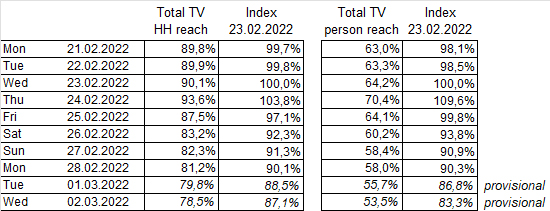Lesya Ukrainka (1871-1913) was a Ukrainian writer and poet in the aftermath of the Russian tsars. Since a few years, she figures on the 200 ₴ banknote of the Ukrainian hryvnia, as an icon of Ukrainian culture and liberation. She was tutored at home by Ukrainian speaking teachers to avoid schools that taught Russian as primary language. Her first poem “Hope”, at age 8, reportedly was a reaction to the arrest and exile of her aunt taking part in a political movement against the tsarist autocracy (see Wikipedia).

Unfortunately, romantic heroes from the past cannot prevent that TV ratings in Ukraine today aren’t worth a single hryvnia. At the same time, the audience figures are a testimony of connections and solidarity between Ukrainians in wartime. The resilience of offline and online media is remarkable. They represent a lifeline between Ukrainians. That is why a seemingly futile tv audience analysis, given the loss of life in Ukraine, still feels appropriate.
The attack on the TV tower in Kyiv had a marginal impact on tv broadcasting. Analog terrestrial delivery has become fairly insignificant in Ukraine, certainly in Kyiv, and all technical platforms and retransmission facilities are freely shared these days. Nevertheless, the war has started to affect tv audience research as well:
- On February 25th, Nielsen Ukraine lost its capacity to time log and identify tv content. They did maintain the delivery of profiled audience data by time band.
- ITK has stopped updating public TAM panel results. Evening news data from February 24th were the last to be published.
- Luckily, subscribers to the tv study continue to receive daily tv data, albeit without program information.
The data for the analysis below were kindly provided by 1+1 broadcasting company.
Table 1 shows the evolution of the number of households for which Nielsen was able to retrieve and validate data (polled households).

As might be expected, the number of ‘useful’ households is falling since the start of the invasion as shown by the index that puts the eve of the invasion ’23.02.2022) at 100%. Beware: the data for March 1st and 2nd will be adjusted upward, due to delayed data delivery for 3 to 5% of households. Nevertheless, tendencies are clear. Data suggest that in weeks’ time about 10% of households are lost for the TAM study.
Table 2 shows the evolution of the reach of all tv stations together (Total TV). Ont the left are the % of households that tune in to their tv set. On the right are the % of household members that effectively watch tv on a given day. Again: figures for yesterday and the day before (1st and 2nd of March) are provisional and may be adjusted a little bit upward in the coming days.

These basic observations trigger a number of research questions we all hope never to be forced to answer. What to do with these disappearing households? And by extension, what to do with the universe definition?
An estimated 1 million people (2,3%) are displaced within Ukraine, a number that could double in the coming days. An estimated 660.000 people (1,5%) already left the country.
- The policy of Nielsen is to consider the unpolled households in times of catastrophe as households that do not watch tv.
- Broadcasters maintain that a big chunk of those people are simply viewing elsewhere (giving a dramatic illustration of a weak point in many classic people meter studies: the measurement of out-of-home viewing...).
- For obvious reasons, statistical weighting procedures are still done on the same universe benchmarks.
The Nielsen policy will probably lead to an underestimation of tv audiences. Keeping the weighting procedures on pre-war universe benchmarks will probably somewhat overestimate tv audiences. Market research can only do what it can do… even in peace time!
At the same time, the fascinating news is that an estimated 80% of households may still be able to watch tv. And while an astounding 70% of Ukrainians followed the first day of the invasion at some point on their first screen, between 55 and 60% of people may still be reached directly by television after one week of war. Besides the very lively internet conversations among Ukrainians and with the outside world.
That is why media professionals continue to work in Ukraine, with ups and downs, fighting panic attacks and supporting each other. A thought well worth remembering while we continue our business as usual.
03.03.2022
Stef Peeters
